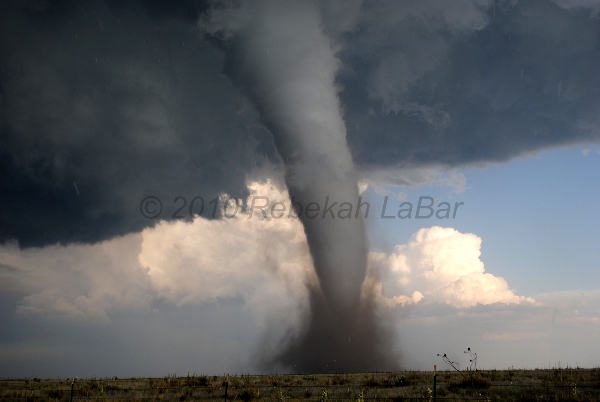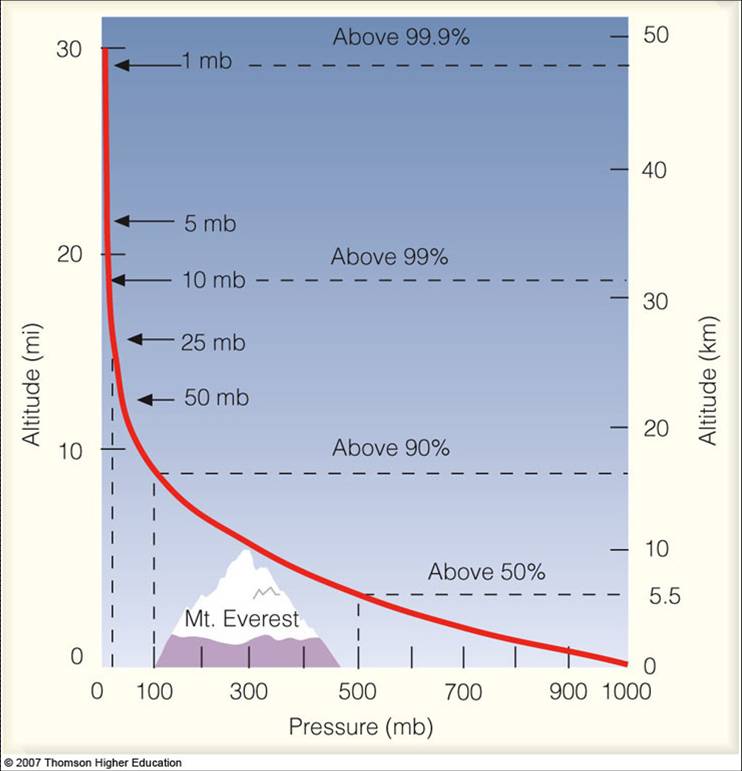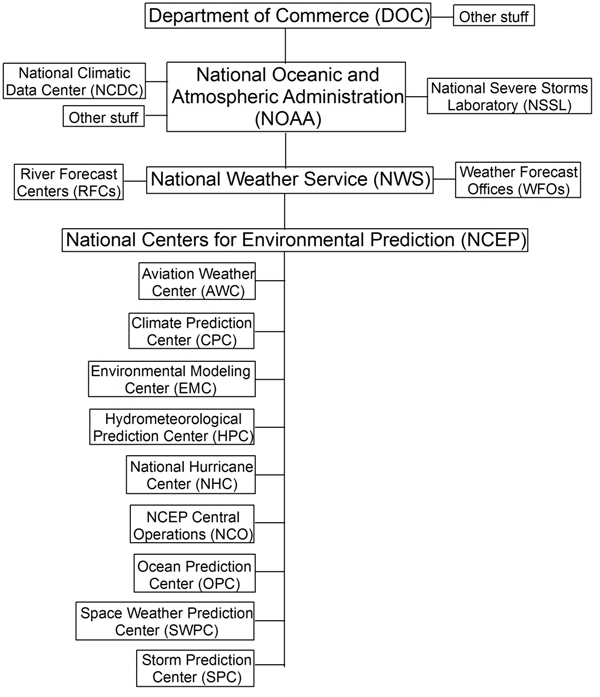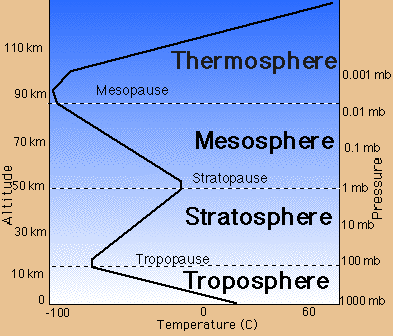01.24.11
Posted in Weather Education at 8:00 am by Rebekah
The seven elements of weather (temperature, pressure, wind, moisture, clouds, precipitation, and visibility) can all be boiled down to temperature, pressure, and moisture. A couple of weeks ago we looked at temperature, last week we looked at pressure, and next week we will look at moisture. Today we’re going to take a brief look at wind, which is related to pressure.
————————————————–
Wind
Wind is the motion of air, caused by a difference in pressure.

As I’ve said before, the earth and the atmosphere is always trying to balance out any inequalities. Note the figure above. The column of air on the left has more molecules (thus has a higher pressure) than the column on the right. Some of these molecules will “want” to move over to the right, to balance out the two columns.
This illustrates a key principle of the atmosphere: wind blows from high to low pressure. Furthermore, the stronger the pressure gradient (i.e., the greater the pressure difference), the stronger the wind (e.g., think of the low pressure inside of and strong pressure gradients in hurricanes).
————————————————–
Come back next Monday as we talk about moisture, the next element of weather.
Permalink
01.20.11
Posted in Weather Education, Weather Myths at 8:00 am by Rebekah

Here are a few myths about tornadoes that you might have heard.
- Myth: “You should open windows to equalize air pressure.”
- Fact: Although tornadoes may have a low pressure center, houses are well-ventilated and pressure differences would be equalized well before explosive pressure drops came close enough to the house. Opening windows is a waste of time and may just bring more flying debris into your home.
- Myth: “You should always shelter from tornadoes in the southwest side of your house.”
- Fact: Tornadoes often come from the southwest, which is possibly related to how this old myth got started. Instead, you should hide in the center of your house, in a closet, underneath heavy furniture, or under a stairwell.
- Myth: “A highway overpass is a good tornado shelter.”
- Fact: Although a TV station video from Kansas in 1991 showed that people got apparent protection under an overpass, they were just providentially spared (not to mention the tornado did not come directly over them, as presumed). An overpass actually creates a wind tunnel effect, such that the winds under the overpass can actually be even stronger than the winds in the tornado. You would also be directly exposed to flying debris. People have been killed hiding under overpasses (most notably on May 3, 1999 in Oklahoma City). Instead, if you are in a car and a tornado is nearby, you should drive away, if possible, or take shelter in any nearby buildings (staying inside a stationary car is not a good idea).
- Myth: “My town is protected from tornadoes by a river, hill, valley, Indian burial ground, etc.”
- Fact: The idea that your town is protected is a combination of perhaps wishful thinking, a short memory, and the rarity of tornadoes. Tornadoes don’t care about surface features, though, they are more driven by what’s going on aloft. When I moved to Norman, I heard that there was a “bubble” or “dome” that seemed to keep tornadoes in Oklahoma City but not Norman. Norman had been struck by tornadoes in the 70s and 80s, but not for a while. Well, the so-called “bubble” was popped recently, as east Norman was hit by a tornado in June 2009 and again by an EF4 tornado in May 2010.
Permalink
01.17.11
Posted in Weather Education at 8:00 am by Rebekah
Last Monday we defined the elements of weather as temperature, pressure, wind, moisture, clouds, precipitation, and visibility. We then took a look at temperature, including what it is and how we define the layers of the atmosphere by temperature (troposphere, stratosphere, mesosphere, and thermosphere).
Today we’re going to look at atmospheric pressure.
————————————————–
Pressure
Pressure is simply defined as force per unit area.
When you sit down on a chair, you are exerting a certain amount of pressure upon the chair due to your weight. Now imagine sitting on a much smaller chair…if the chair is small enough, it’s possible that it might break, as your weight is now distributed across a much smaller surface area (read: the pressure is higher).
Wherever you are on earth, there is a “column” of air above you that is exerting pressure on you (due to the weight of the air molecules). This is what we mean by atmospheric pressure.
Pressure Units
- Pounds per square inch (psi)
- Inches of mercury (in. Hg) – old mercury barometers measured pressure based on how high the mercury rose in a glass tube
- Millibars (mb) or hectoPascals (hPa) – meteorological measurement of pressure (1 mb = 1 hPa)
Ideal Gas Law
While the atmosphere is not entirely made up of ideal gases, the ideal gas law is still a good representation of how air behaves based on the temperature, pressure, and volume. In terms of a column of air sitting above a certain point, the ideal gas law is as follows:
pV = nRT
- p = pressure exerted by air column
- V = volume of air column
- n = number of air molecules in the column
- R = gas constant
- T = temperature of the air column
Changes in Pressure
Based on the ideal gas law, we can make a few assumptions, all of which should be fairly intuitive:
- If the volume goes up, the pressure goes down…think about 20 marbles moving around inside a container; if you put those marbles inside a larger container, and they’re still moving at the same speed, then you would expect there to be less pressure with the larger container
- If the number of molecules goes up, the pressure goes up…now put 20 more marbles inside the container, all moving at the same speed; you should expect the pressure to be higher now
- If the temperature goes up, the pressure goes up…let’s say the marbles speed up, symbolizing a higher temperature; you should expect the pressure to be higher, as the marbles are now hitting the sides of the container more frequently
Pressure Structure of the Atmosphere
Meteorologists use pressure as a vertical coordinate (we often use it instead of altitude). As you would expect, pressure decreases as you go up…remember that airplane cabins must be pressurized and mountain climbers must carry oxygen as the air is so thin.

Source: Lyndon State College
Sea-level pressure is 1013 mb. A strong high pressure system might have a pressure of 1040 mb, while a strong low-pressure system might have a pressure of 960 mb (some hurricanes have a pressure as low as 900 mb).
Pressure Corrections
Since the surface pressure at Denver is always going to be lower than the pressure at San Francisco, we do have to make a slight correction for height. We calculate what we call the mean sea-level pressure (MSLP) at every location, so we sort-of level the ground to calculate what the pressure would be at that location if there were no mountains (otherwise, it would look like there is always a low-pressure system over the mountains).
————————————————–
Come back next Monday to learn about the wind, another element of weather related to pressure.
Permalink
01.13.11
Posted in Weather - Miscellaneous, Weather Education at 8:00 am by Rebekah

Here’s how NOAA, the NWS, and all of those other weather-related offices you hear about are connected. For more, read on.
The National Oceanic and Atmospheric Administration (NOAA) is part of the Department of Commerce. NOAA’s basic mission is to forecast and research conditions of the oceans and atmosphere.
NOAA has many branches, including the National Climatic Data Center (NCDC) in Asheville, North Carolina, the world’s largest active archive of weather data; the National Severe Storms Laboratory (NSSL) in Norman, Oklahoma, a weather research department; and the National Weather Service (NWS), headquartered in Silver Spring, Maryland.
The National Weather Service also has a few branches, including what most people are most familiar with, the local weather forecast offices (WFOs). There are 122 WFOs across the U.S., each charged with the duty of issuing local forecasts and warnings to the general public. The NWS also has 13 River Forecast Centers (RFCs), each of which issues, well, river forecasts.
The National Centers for Environmental Prediction (NCEP), headquartered in Camp Springs, Maryland, is also part of the NWS. There are nine branches of NCEP:
- Aviation Weather Center (AWC) in Kansas City, Missouri – provides aviation warnings and forecasts of hazardous flight conditions for domestic and international air space
- Climate Prediction Center (CPC) in Camp Springs, Maryland – monitors and forecasts short-term climate fluctuations
- Environmental Modeling Center (EMC) in Camp Springs, Maryland – develops and improves numerical weather, climate, hydrological, and ocean prediction via research
- Hydrometeorological Prediction Center (HPC) in Camp Springs, Maryland – provides nationwide analysis and forecast products (with an emphasis on precipitation) out through seven days
- National Hurricane Center (NHC) in Miami, Florida – provides tropical weather forecasts and issues watches and warnings for the U.S. and surrounding areas
- NCEP Central Operations (NCO) in Camp Springs, Maryland – maintains and runs operational analyses and forecast models
- Ocean Prediction Center (OPC) in Camp Springs, Maryland – issues weather warnings and forecasts out to five days for the Atlantic and Pacific Oceans north of 30°N
- Space Weather Prediction Center (SWPC) in Boulder, Colorado – provides space weather alerts and warnings for disturbances that can affect people and equipment working in space and on earth
- Storm Prediction Center (SPC) in Norman, Oklahoma – provides tornado and severe thunderstorm watches for the contiguous U.S. along with a suite of hazardous weather forecasts
The National Weather Service was originally called the Weather Bureau. The Weather Bureau was established in 1870 under the War Department, but moved to the Department of Agriculture in 1890. In 1940, it was moved to the Department of Commerce, and in 1967, it became known as the National Weather Service. For more on the history of the NWS, see the NWS timeline and history pages.
Permalink
01.10.11
Posted in Weather Education at 8:00 am by Rebekah
Last Monday we took a look at some basic definitions in meteorology, including meteorology, the atmosphere, weather (as well as why we have weather), and climate.
Today we’re going to start reviewing the elements of weather, starting with temperature.
————————————————–
Elements of Weather
Temperature
Temperature is a measure of the kinetic energy of all the molecules in a substance. The faster the molecules are moving, the higher the temperature. Alternatively, you can think of it the other way around; for example, the warmer a pot of water, the more the water molecules are moving (i.e., the water may eventually evaporate)…or, the colder a pot of water, the less the molecules are moving (i.e., the water may eventually freeze).
Temperature Scales
There are 3 primary temperature scales: Fahrenheit, Celsius, and Kelvin. Click here to see more on these temperature scales, including how to convert between the three.
Temperature Structure of the Atmosphere

Source: NASA
Categorized by air temperature, there are four layers of the atmosphere:
- Troposphere – the lowest layer of the atmosphere…air temperature generally decreases with height, as the earth is better than air at absorbing incoming solar radiation (thus it is kept warmer)
- Stratosphere – above the troposphere (the boundary is known as the tropopause)…air temperature generally increases with height, as a layer of ozone efficiently absorbs solar radiation
- Mesosphere – above the stratosphere (the boundary is known as the stratopause)…air temperature generally decreases with height, for the same reason as the troposphere
- Thermosphere – above the mesosphere (the boundary is called the mesopause)…air temperature generally increases with height, as there is such a lack of air molecules (the few molecules that are there do not have to “share” as much solar radiation with other molecules, thus they become more energetic)
————————————————–
Come back next Monday to learn about pressure, another element of weather.
Permalink
« Previous Page — « Previous entries « Previous Page · Next Page » Next entries » — Next Page »




